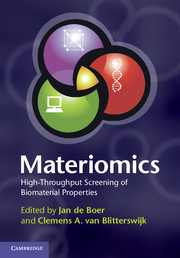Book contents
- Frontmatter
- Contents
- List of contributors
- Preface
- Chapter 1 Introducing materiomics
- Chapter 2 Physico-chemical material properties and analysis techniques relevant in high-throughput biomaterials research
- Chapter 3 Materiomics using synthetic materials: metals, cements, covalent polymers and supramolecular systems
- Chapter 4 Microfabrication techniques in materiomics
- Chapter 5 Bioassay development
- Chapter 6 High-content imaging
- Chapter 7 Computational analysis of high-throughput material screens
- Chapter 8 Upscaling of high-throughput material platforms in two and three dimensions
- Chapter 9 Development of materials for regenerative medicine: from clinical need to clinical application
- Chapter 10 Non-biomedical applications of materiomics
- Chapter 11 Beyond bed and bench
- Index
- References
Chapter 8 - Upscaling of high-throughput material platforms in two and three dimensions
Published online by Cambridge University Press: 05 April 2013
- Frontmatter
- Contents
- List of contributors
- Preface
- Chapter 1 Introducing materiomics
- Chapter 2 Physico-chemical material properties and analysis techniques relevant in high-throughput biomaterials research
- Chapter 3 Materiomics using synthetic materials: metals, cements, covalent polymers and supramolecular systems
- Chapter 4 Microfabrication techniques in materiomics
- Chapter 5 Bioassay development
- Chapter 6 High-content imaging
- Chapter 7 Computational analysis of high-throughput material screens
- Chapter 8 Upscaling of high-throughput material platforms in two and three dimensions
- Chapter 9 Development of materials for regenerative medicine: from clinical need to clinical application
- Chapter 10 Non-biomedical applications of materiomics
- Chapter 11 Beyond bed and bench
- Index
- References
Summary
Scope
High-throughput screening (HTS) is carried out on two- (2D) and three-dimensional (3D) materials, with hundreds to thousands of conditions at various size scales. When hits are successfully found in HTS systems, upscaling to clinically relevant surfaces needs to be performed to validate whether the identified material and functionality can be replicated on the macroscale. In doing so, parameters such as surface chemistry, topography and sample dispensing must be controlled to maintain reproducibility. Here, we discuss the methods harnessed to replicate chemical and topographical features from the nano- to the macroscale in 2D and 3D systems. Technologies to control cell adhesion and 3D scaffold fabrication are introduced and discussed in terms of their potential for HTS.
Basic upscaling principles
HTS is a highly automated process that tests small amounts of large numbers of compounds for a desired function. In the previous chapters of this book, the general principles behind material chemistry and resulting physico-chemical properties, combinatorial chemistry, microfabrication technologies and development of tools to perform biological assays on HTS platforms have been described. These elements partly return here, where basic principles of polymer chemistry and surface topographies are introduced in the context of facing the technological challenges to upscale selected candidates to larger surfaces or medical devices with complex curved shapes. In addition, the basic principles behind implant fabrication technologies and precise cell deposition are discussed to illustrate the steps required to assimilate HTS into clinically relevant 3D systems.
Information
- Type
- Chapter
- Information
- MateriomicsHigh-Throughput Screening of Biomaterial Properties, pp. 133 - 154Publisher: Cambridge University PressPrint publication year: 2013
References
Accessibility standard: Unknown
Why this information is here
This section outlines the accessibility features of this content - including support for screen readers, full keyboard navigation and high-contrast display options. This may not be relevant for you.Accessibility Information
- 1
- Cited by
